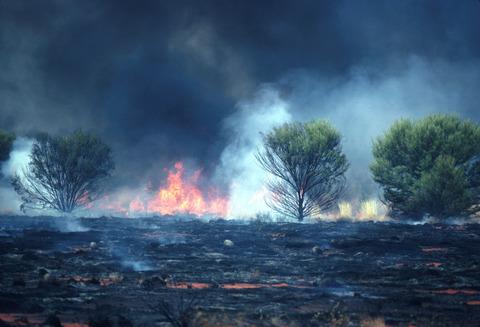当前位置:
X-MOL 学术
›
Funct. Ecol.
›
论文详情
Our official English website, www.x-mol.net, welcomes your
feedback! (Note: you will need to create a separate account there.)
Effects of plant hydraulic traits on the flammability of live fine canopy fuels
Functional Ecology ( IF 4.6 ) Pub Date : 2021-02-10 , DOI: 10.1111/1365-2435.13771 F.R. Scarff 1 , T. Lenz 1 , A.E. Richards 1, 2 , A.E. Zanne 3 , I.J. Wright 1 , M. Westoby 1
中文翻译:

植物水力性状对精细冠层活燃料的可燃性的影响
更新日期:2021-04-06
Functional Ecology ( IF 4.6 ) Pub Date : 2021-02-10 , DOI: 10.1111/1365-2435.13771 F.R. Scarff 1 , T. Lenz 1 , A.E. Richards 1, 2 , A.E. Zanne 3 , I.J. Wright 1 , M. Westoby 1
Affiliation

|
- Plant species vary in how they regulate moisture and this has implications for their flammability during wildfires. We explored how fuel moisture is shaped by variation within five hydraulic traits: saturated moisture content, cell wall rigidity, cell solute potential, symplastic water fraction and tissue capacitance.
- Using pressure–volume curves, we measured these hydraulic traits in twigs and distal shoots (i.e. twigs + leaves) in 62 plant species across four wooded communities in south‐eastern Australia. Moisture content of fine fuels was then estimated for circumstances typical of fire weather. These projections were made assuming that under the hot, dry, windy conditions typical of large wildfires, leaves and fine twigs would function at internal water pressures close to wilting point (i.e. turgor loss point, TLP). The effect of different moisture contents at TLP on ignition time was then modelled using a fully mechanistic, finite element model of biomass ignition based on standard principles of physical chemistry.
- We also measured predawn water potential, an indication of plant access to soil water that is influenced by root architecture. These data were used to model how root traits influence fuel moisture and ignition time.
- Most variation among species in fuel moisture under fire weather conditions arose from differences in saturated moisture content (3.4‐ to 3.6‐fold variation). Twig capacitance was also an important driver of fuel moisture under these weather conditions (1.9‐ to 2.2‐fold variation in moisture content). A suite of other leaf and root traits influencing how much shoots dry out as they approach wilting point each contributed 1.0‐ to 1.6‐fold variation in projected fuel moisture during fire weather. Fuel moisture variation in turn drove variation in flammability by modifying predicted ignition time.
- Two main life‐history types in fire‐prone habitats are obligate seeders and resprouters. There were no significant differences between these species groups in estimated fuel moisture during fire weather, nor in any measured hydraulic traits.
- Live fuel moisture is an important determinant of wildfire activity. Our data show that variation in tissue saturated moisture content among co‐occurring species represents an important ecological store of variation in flammability in the study communities.
中文翻译:

植物水力性状对精细冠层活燃料的可燃性的影响
- 植物种类在调节水分方面的方法各不相同,这对野火期间的可燃性具有影响。我们探索了如何通过五个水力特性的变化来塑造燃料水分:饱和水分含量,细胞壁刚度,细胞溶质势,共生水分数和组织电容。
- 使用压力-体积曲线,我们测量了澳大利亚东南部四个树木繁茂社区中62种植物的树枝和远枝(即树枝+树叶)中的水力特性。然后,针对典型的火灾天气情况,估算了精细燃料的水分含量。这些预测是假设在大野火,树叶和细树枝典型的炎热,干燥,大风条件下,在接近枯萎点(即膨松损失点,TLP)的内部水压下可以起作用的。然后,根据物理化学的标准原理,使用完全机械的,有限的生物质点火的有限元模型,模拟了TLP时不同水分含量对点火时间的影响。
- 我们还测量了黎明前的水势,这表明植物获得根系结构影响的土壤水。这些数据被用来模拟根性状如何影响燃料的水分和点火时间。
- 在火灾天气条件下,燃料水分中物种之间的大部分差异是由于饱和水分含量的差异(差异为3.4倍至3.6倍)引起的。在这些天气条件下(水分含量变化为1.9到2.2倍),细枝电容也是燃料水分的重要驱动因素。一组其他的叶和根性状会影响芽在接近枯萎时变干的程度,在火灾天气中,每种燃料和燃料的含水量变化都在1.0到1.6倍之间。燃油湿度的变化又通过修改预测的点火时间来驱动可燃性的变化。
- 易火生境中的两种主要生活史类型是专性播种者和繁殖者。这些物种组之间在火灾天气期间的估计燃料湿度和任何测得的水力特性方面均无显着差异。
- 活燃料的水分是野火活动的重要决定因素。我们的数据表明,共生物种之间组织饱和水分含量的变化代表了研究社区可燃性变化的重要生态存储。











































 京公网安备 11010802027423号
京公网安备 11010802027423号